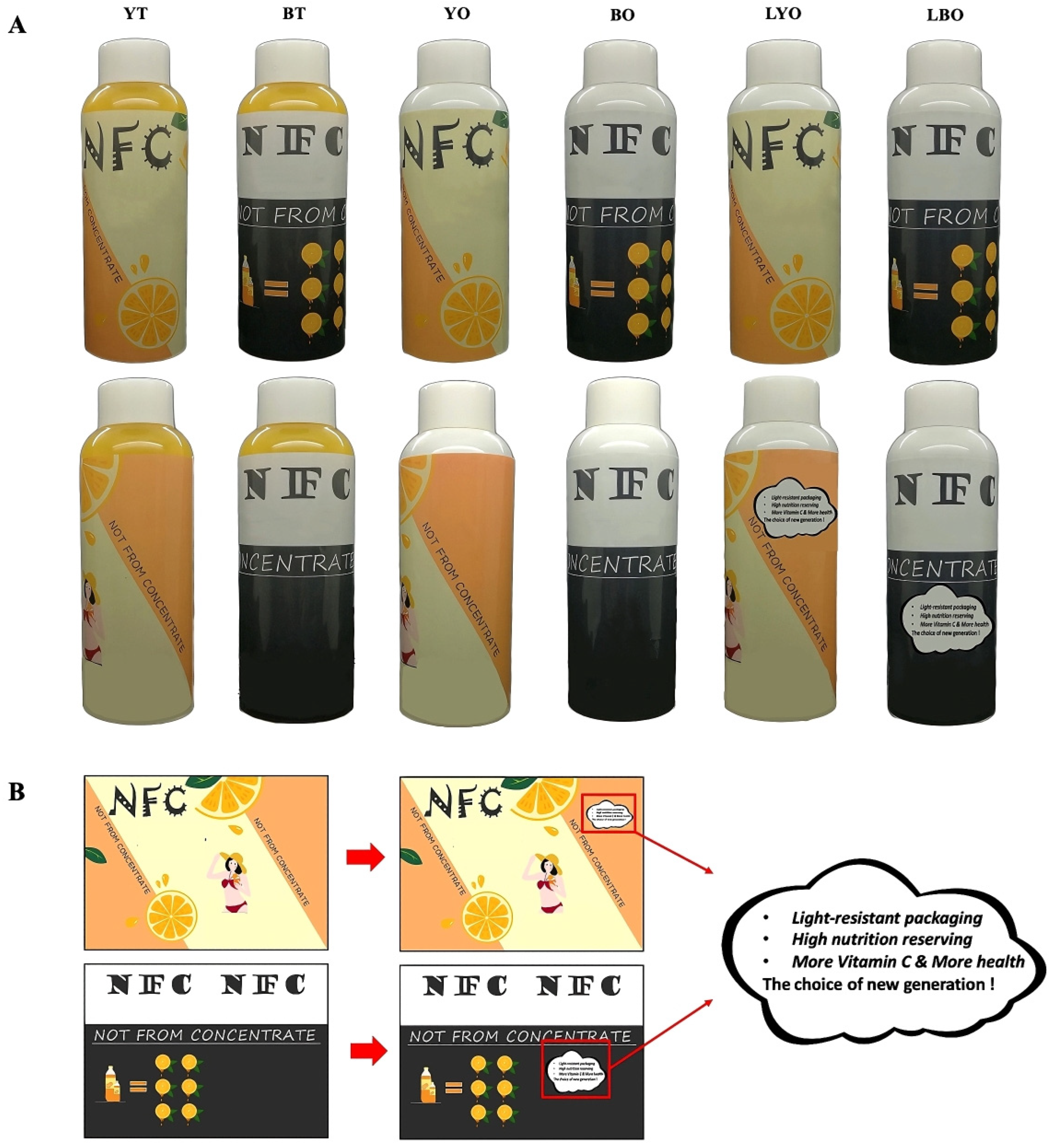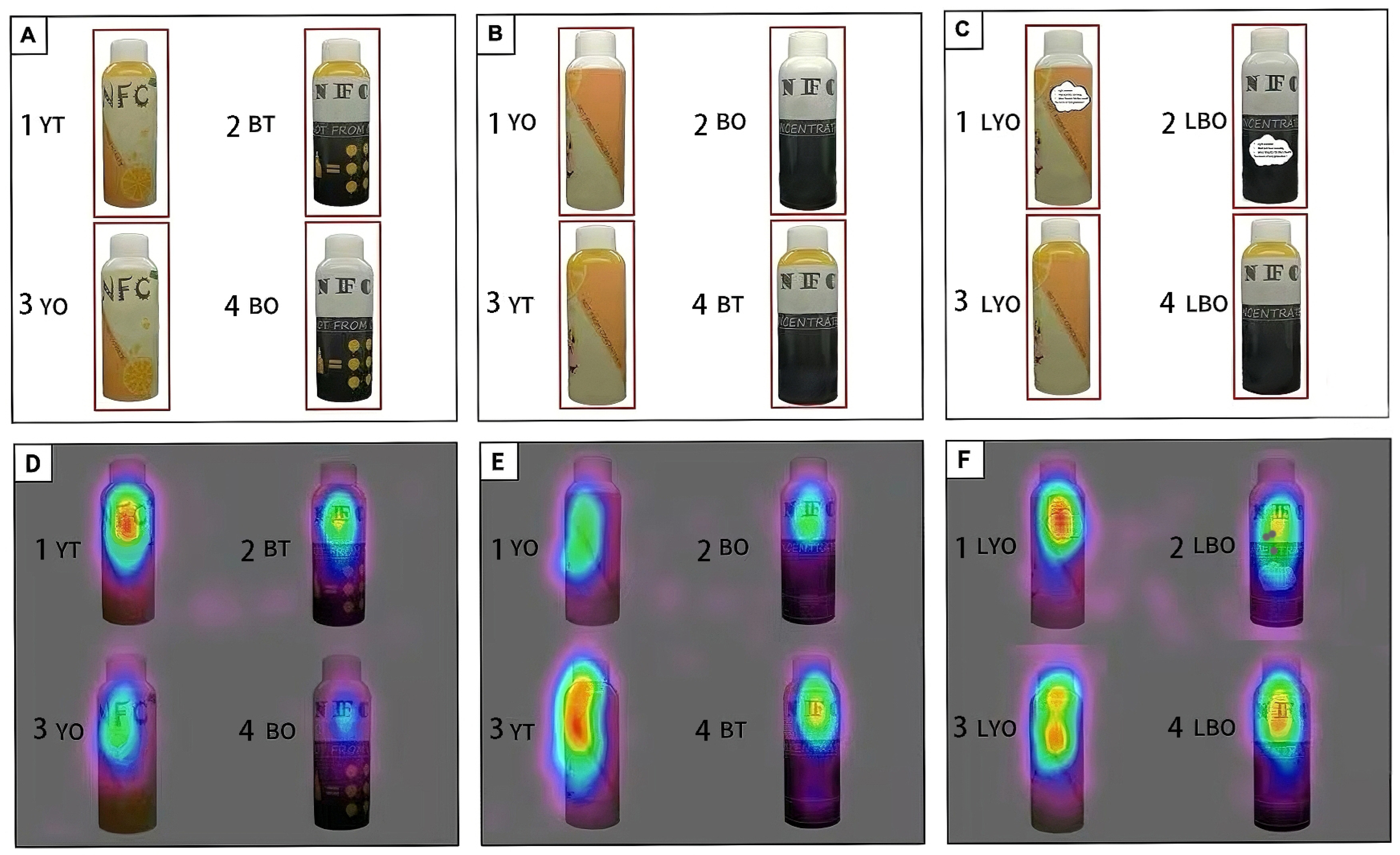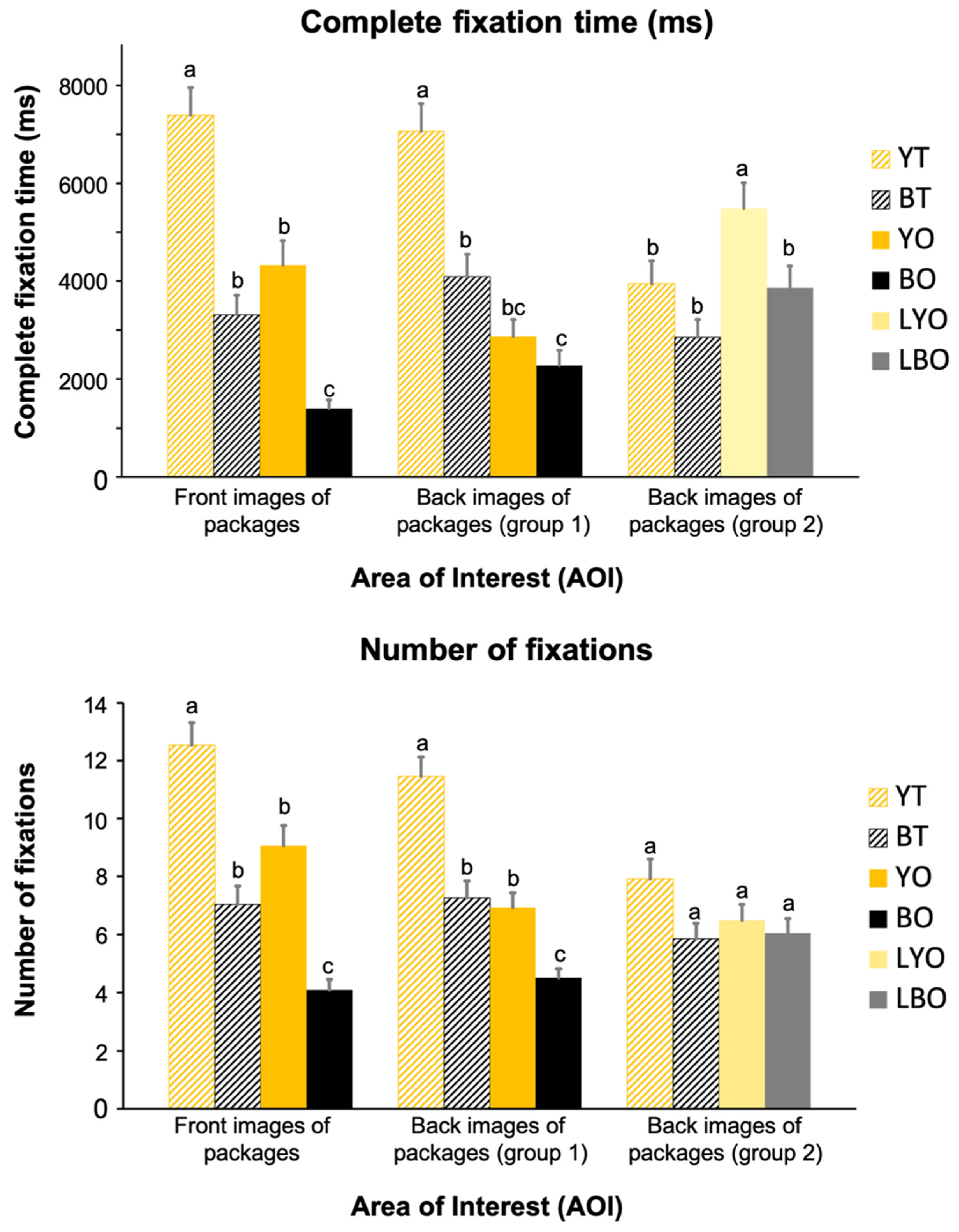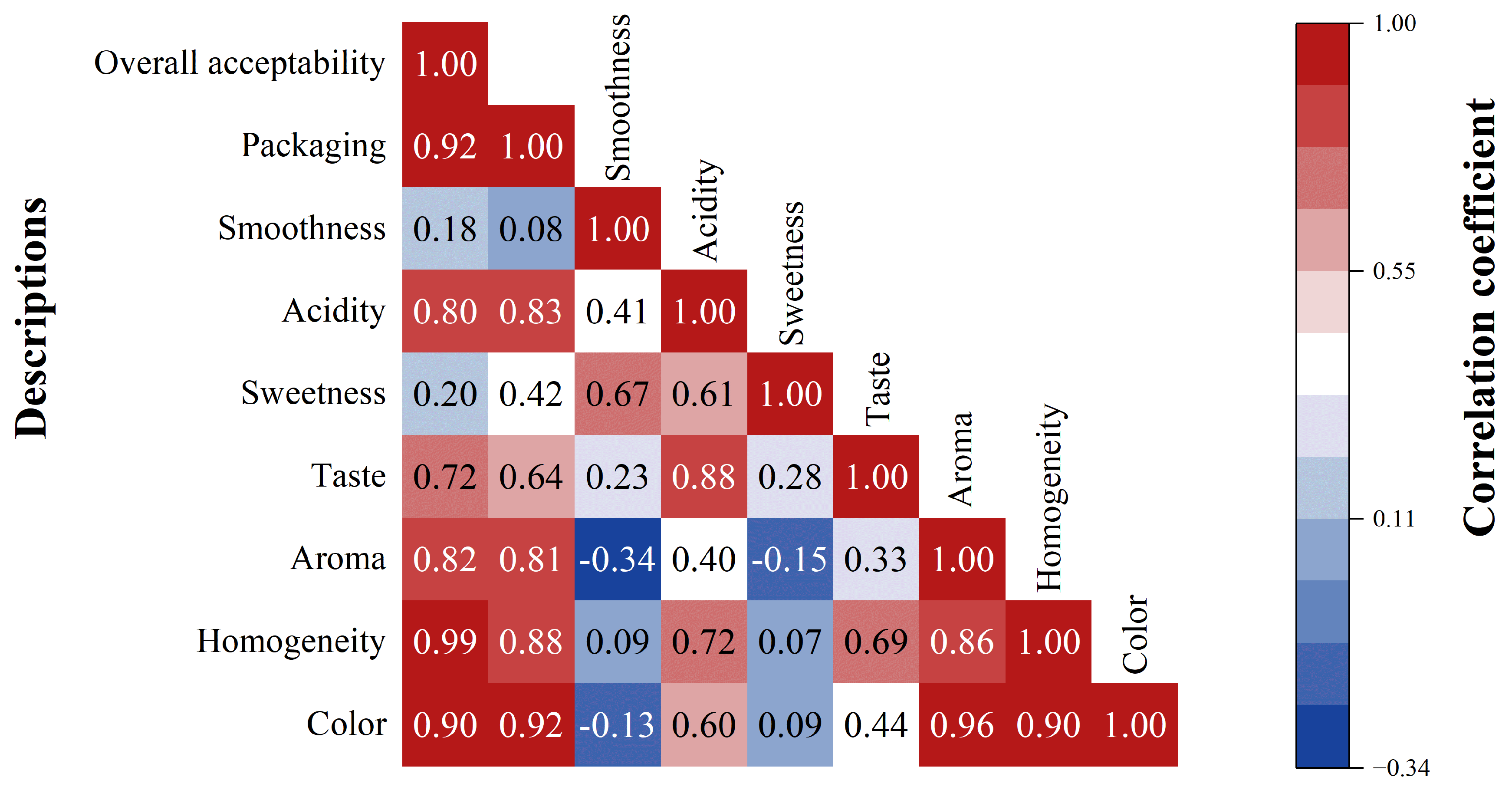Impact of High-Barrier Packaging Design on Consumer Preference for Not from Concentrated Orange Juice
Abstract
1. Introduction
2. Materials and Methods
2.1. Packaging Design
2.2. Eye-Tracking
2.2.1. Recruitment of Participants
2.2.2. Eye-Tracking Experiment
2.3. Sensory Evaluation Experiment
2.3.1. Sample Preparation of NFC Orange Juice
2.3.2. Recruitment of Participants
2.3.3. Sensory Evaluation Scheme
2.4. Data Analysis
3. Results and Discussion
3.1. Eye-Tracking Experiment for Different Packaging
3.2. Sensory Evaluation for NFC Orange Juice in Different Packaging
3.3. Limitations
4. Conclusions
Author Contributions
Funding
Institutional Review Board Statement
Informed Consent Statement
Data Availability Statement
Conflicts of Interest
References
- Sousa, M.M.M.d.; Carvalho, F.M.; Pereira, R.G.F.A. Colour and shape of design elements of the packaging labels influence consumer expectations and hedonic judgments of specialty coffee. Food Qual. Prefer. 2020, 83, 103902. [Google Scholar] [CrossRef]
- Gidlöf, K.; Anikin, A.; Lingonblad, M. Looking is buying. How visual attention and choice are affected by consumer preferences and properties of the supermarket shelf. Appetite 2017, 116, 29–38. [Google Scholar] [CrossRef] [PubMed]
- Nguyen, T.H.N.; Tran, N.K.H.; Do, K.D. The Role of Product Visual Appeal and Sale Promotion Program on Consumer Impulsive Buying Behavior. ESJ 2024, 8, 297–309. [Google Scholar] [CrossRef]
- Peschel, A.O.; Orquin, J.L.; Mueller Loose, S. Increasing consumers’ attention capture and food choice through bottom-up effects. Appetite 2018, 132, 1–7. [Google Scholar] [CrossRef] [PubMed]
- Spence, C. Crossmodal correspondences: A tutorial review. Atten. Percept. Psychophys. 2011, 73, 971–995. [Google Scholar] [CrossRef] [PubMed]
- Velasco, C.; Michel, C.; Youssef, J.; Gamez, X.; Cheok, A.D.; Spence, C. Colour–taste correspondences: Designing food experiences to meet expectations or to surprise. Int. J. Food Des. 2016, 1, 83–102. [Google Scholar] [CrossRef]
- Velasco, C.; Woods, A.; Deroy, O.; Spence, C. Hedonic mediation of the crossmodal correspondence between taste and shape. Food Qual. Prefer. 2015, 41, 151–158. [Google Scholar] [CrossRef]
- Mehta, A.; Serventi, L.; Kumar, L.; Torrico, D.D. Exploring the effects of packaging on consumer experience and purchase behaviour: Insights from eye tracking and facial expressions on orange juice. Int. J. Food Sci. Technol. 2024, 59, 8445–8460. [Google Scholar] [CrossRef]
- Sellami, I.; Mall, V.; Schieberle, P. Changes in the Key Odorants and Aroma Profiles of Hamlin and Valencia Orange Juices Not from Concentrate (NFC) during Chilled Storage. J. Agric. Food Chem. 2018, 66, 7428–7440. [Google Scholar] [CrossRef]
- Sun, R.; Xing, R.; Zhang, J. Quality changes of HHP orange juice during storage: Metabolomic data integration analyses. Food Chem. 2023, 404, 134612. [Google Scholar] [CrossRef]
- Nisticò, R. Polyethylene terephthalate (PET) in the packaging industry. Polym. Test. 2020, 90, 106707. [Google Scholar] [CrossRef]
- Benyathiar, P.; Kumar, P.; Carpenter, G.S. Polyethylene Terephthalate (PET) Bottle-to-Bottle Recycling for the Beverage Industry: A Review. Polymers 2022, 14, 2366. [Google Scholar] [CrossRef] [PubMed]
- Cadwallader, D.C.; Gerard, P.D.; Drake, M.A. The role of packaging on the flavor of fluid milk. J. Dairy Sci. 2023, 106, 151–167. [Google Scholar] [CrossRef] [PubMed]
- Khajavi, M.Z.; Ebrahimi, A.; Yousefi, M. Strategies for Producing Improved Oxygen Barrier Materials Appropriate for the Food Packaging Sector. Food Eng. Rev. 2020, 12, 346–363. [Google Scholar] [CrossRef]
- Zhao, J.; Qu, Z.; Li, A. A High Barrier and Sustained Release Oxygen-Absorbing Ionic Polymer for Food Packaging Applications. J. Food Sci. 2020, 85, 143–149. [Google Scholar] [CrossRef]
- Masamba, M. Impact of Food Packaging Materials on the Shelf-Life and Quality of Packaged Food Products. J. Food Sci. 2024, 5, 15–28. [Google Scholar] [CrossRef]
- Kim, D.H.; Ryu, Y.S.; Kim, S.H. Improvements in the oxygen barrier property of polypropylene nanocomposites. Polym. Adv. Technol. 2018, 29, 2655–2664. [Google Scholar] [CrossRef]
- Berlinet, C.; Brat, P.; Ducruet, V. Quality of orange juice in barrier packaging material. Packag. Technol. Sci. 2007, 21, 279–286. [Google Scholar]
- Yun, X.; Dong, T. Fabrication of high-barrier plastics and its application in food packaging. In Food Packaging; Academic Press: Cambridge, MA, USA, 2017; pp. 147–184. [Google Scholar]
- Kardas, M.; Rakuła, M.; Kołodziejczyk, A. Consumer Preferences, Sensory Evaluation, and Color Analysis of Beetroot and Tomato Juices: Implications for Product Development and Marketing in Health-Promoting Beverages. Foods 2024, 13, 4059. [Google Scholar] [CrossRef]
- Bou-Mitri, C.; Abdessater, M.; Zgheib, H. Food packaging design and consumer perception of the product quality, safety, healthiness and preference. Nutr. Food Sci. 2020, 51, 71–86. [Google Scholar] [CrossRef]
- Hallez, L.; Vansteenbeeck, H.; Boen, F. Persuasive packaging? The impact of packaging color and claims on young consumers’ perceptions of product healthiness, sustainability and tastiness. Appetite 2023, 182, 106433. [Google Scholar] [CrossRef]
- Mandle, J.; Tugendhaft, A.; Michalow, J. Nutrition labelling: A review of research on consumer and industry response in the global South. Glob. Health Action 2015, 8, 25912. [Google Scholar] [CrossRef]
- Ares, G.; Piqueras-Fiszman, B.; Varela, P. Food labels: Do consumers perceive what semiotics want to convey? Food Qual. Prefer. 2011, 22, 689–698. [Google Scholar] [CrossRef]
- Peng, M.; Xu, Z.; Huang, H. How Does Information Overload Affect Consumers’ Online Decision Process? An Event-Related Potentials Study. Front. Neurosci. 2021, 15, 695852. [Google Scholar] [CrossRef] [PubMed]
- Clement, J. Visual influence on in-store buying decisions: An eye-track experiment on the visual influence of packaging design. J. Mark. Manag. 2007, 23, 917–928. [Google Scholar] [CrossRef]
- Huddleston, P.; Behe, B.K.; Driesener, C. Inside-outside: Using eye-tracking to investigate search-choice processes in the retail environment. J. Retail. Consum. Serv. 2018, 43, 85–93. [Google Scholar] [CrossRef]
- Peša, A.R.; Valčić, M.; Smokrović, A.M. Overview of the Use of Eye-Tracking Technology for Monitoring Consumer Views. Our Econ. 2024, 70, 61–70. [Google Scholar] [CrossRef]
- Agost, M.; Bayarri-Porcar, V. The Use of Eye-Tracking to Explore the Relationship Between Consumers’ Gaze Behaviour and Their Choice Process. Big Data Cogn. Comput. 2024, 8, 184. [Google Scholar] [CrossRef]
- Liu, X.; Cui, Y. Eye tracking technology for examining cognitive processes in education: A systematic review. Comput. Educ. 2025, 229, 105263. [Google Scholar] [CrossRef]
- Graham, D.J.; Orquin, J.L.; Visschers, V. Eye tracking and nutrition label use: A review of the literature and recommendations for label enhancement. Food Policy 2012, 37, 378–382. [Google Scholar] [CrossRef]
- Ribeiro, A.P.L.; Carneiro, J.D.S.; Ramos, T.M.; Patterson, L.; Pinto, S.M. Determining how packaging and labeling of Requeijão cheese affects the purchase behavior of consumers of different age groups. Br. Food J. 2018, 120, 1183–1194. [Google Scholar] [CrossRef]
- Spence, C. Multisensory packaging design: Colour, shape, texture, sound, and smell. In Integrating the Packaging and Product Experience in Food and Beverages; Woodhead Publishing: Sawston, UK, 2016; pp. 1–22. [Google Scholar] [CrossRef]
- Tapang, R.K.; Espineda, M.N. Empowering Inclusivity: Understanding and Designing for Color Vision Deficiency in Consumer Behavior and Product Packaging. Arch. Des. Res. 2024, 37, 27–41. [Google Scholar] [CrossRef]
- Činjarević, M.; Agić, E.; Dizdarević, E.; Alić, A.; Halilbašić, M. Design and packaging: An important factor in consumer behavior when buying juices. Econ. Anal. 2021, 54, 82–93. [Google Scholar] [CrossRef]
- Koo, W.; Hardin, R.; Childs, M.; Park, K. College Students’ Purchase Behaviors of Single-Serve Premium Juices. J. Appl. Mark. Theory 2022, 9, 104. [Google Scholar]
- Goldman, R.; Linakis, S.; Gillman, M.; Block, J. “If it tastes good, I’m drinking it”: Qualitative study of beverage consumption among college students. J. Adolesc. Health 2013, 52, 702–706. [Google Scholar]
- ISO 5492:2008; Sensory Analysis—Vocabulary. International Organization for Standardization: Geneva, Switzerland, 2008.
- ISO 8589:2007; Sensory Analysis—General Guidance for the Design of Test Rooms. International Organization for Standardization: Geneva, Switzerland, 2007.
- Jiang, J.; Yang, Z.; Liu, M.; Velasco, C.; Woods, A.; Spence, C. Love the color, love its flavor: Preference transfer between visual and gustatory modalities. Int. J. Gastron. Food Sci. 2024, 35, 100891. [Google Scholar] [CrossRef]
- Simmonds, G.; Spence, C. Thinking inside the box: How seeing products on, or through, the packaging influences consumer perceptions and purchase behaviour. Food Qual. Prefer. 2017, 62, 340–351. [Google Scholar] [CrossRef]
- Wan, X.; Woods, A.T.; Jacquot, M.; Knoeferle, K.; Kikutani, M.; Spence, C. The Effects of Receptacle on the Expected Flavor of a Colored Beverage: Cross-Cultural Comparison Among French, Japanese, and Norwegian Consumers. J. Sens. Stud. 2016, 31, 233–244. [Google Scholar] [CrossRef]
- Summerfield, C.; Egner, T. Expectation (and attention) in visual cognition. Trends Cogn. Sci. 2009, 13, 403–409. [Google Scholar] [CrossRef]
- Rangelov, D.; Mattingley, J. Evidence accumulation during perceptual decision-making is sensitive to the dynamics of attentional selection. NeuroImage 2020, 220, 117093. [Google Scholar] [CrossRef]
- Baluch, F.; Itti, L. Mechanisms of top-down attention. Trends Neurosci. 2011, 34, 210–224. [Google Scholar] [CrossRef] [PubMed]
- Clement, J.; Kristensen, T.; Grønhaug, K. Understanding consumers’ in-store visual perception: The influence of package design features on visual attention. J. Retail. Consum. Serv. 2013, 20, 234–239. [Google Scholar] [CrossRef]
- Trentin, C.; Slagter, H.; Olivers, C. Visual working memory representations bias attention more when they are the target of an action plan. Cognition 2022, 230, 105274. [Google Scholar] [CrossRef] [PubMed]
- Wedel, M.; Pieters, R. Eye Tracking for Visual Marketing. Found. Trends Mark. 2008, 1, 231–320. [Google Scholar] [CrossRef]
- Spence, C.; Levitan, C.A.; Shankar, M.U.; Zampini, M. Does food color influence taste and flavor perception in humans? Chemosens. Percept. 2010, 3, 68–84. [Google Scholar] [CrossRef]
- Spence, C. On the psychological impact of food colour. Flavour 2015, 4, 21. [Google Scholar] [CrossRef]
- Spence, C.; Piqueras-Fiszman, B. 6—Food Color and Its Impact on Taste/Flavor Perception. In Multisensory Flavor Perception; Woodhead Publishing: Sawston, UK, 2016; pp. 107–132. [Google Scholar] [CrossRef]
- Baptista, I.; Valentin, D.; Saldaña, E. Effects of packaging color on expected flavor, texture, and liking of chocolate in Brazil and France. Int. J. Gastron. Food Sci. 2021, 24, 100340. [Google Scholar] [CrossRef]
- Spence, C.; Velasco, C. On the multiple effects of packaging colour on consumer behaviour and product experience in the ‘food and beverage’ and ‘home and personal care’ categories. Food Qual. Prefer. 2018, 68, 226–237. [Google Scholar] [CrossRef]
- Spence, C.; Okajima, K.; Cheok, A.D.; Petit, O.; Michel, C. Eating with our eyes: From visual hunger to digital satiation. Brain Cogn. 2016, 110, 53–63. [Google Scholar] [CrossRef]
- Siegrist, M.; Cousin, M.E.; Kastenholz, H.; Wiek, A. Public acceptance of nanotechnology foods and food packaging: The influence of affect and trust. Appetite 2007, 49, 459–466. [Google Scholar] [CrossRef]
- Young, E.; Mirosa, M.; Bremer, P. A Systematic Review of Consumer Perceptions of Smart Packaging Technologies for Food. Front. Sustain. Food Syst. 2020, 4, 63. [Google Scholar]
- Deliza, R.; Rosenthal, A.; Abadio, F.B.D.; Silva, C.H.O.; Castillo, C. Application of high pressure technology in the fruit juice processing: Benefits perceived by consumers. J. Food Eng. 2005, 67, 241–246. [Google Scholar] [CrossRef]
- Mehta, A.; Serventi, L.; Kumar, L. Influence of expectations and emotions raised by packaging characteristics on orange juice acceptability and choice. Food Packag. Shelf Life 2022, 33, 100926. [Google Scholar] [CrossRef]
- Barokas, G. Dynamic choice under familiarity-based attention. Soc. Choice Welf. 2021, 57, 703–720. [Google Scholar] [CrossRef]
- Hoegg, J.A.; Alba, J.W. Taste perception: More than meets the tongue. J. Consum. Res. 2007, 33, 490–498. [Google Scholar] [CrossRef]
- Krishna, A. An integrative review of sensory marketing: Engaging the senses to affect perception, judgment and behavior. J. Consum. Psychol. 2012, 22, 332–351. [Google Scholar] [CrossRef]
- Becker, L.; van Rompay, T.J.L.; Schifferstein, H.N.J.; Galetzka, M. Tough package, strong taste: The influence of packaging design on taste impressions and product evaluations. Food Qual. Prefer. 2011, 22, 17–23. [Google Scholar] [CrossRef]
- Trinh, B.; Meyerding, S. A cross-cultural study: How product attributes and cultural values influence chocolate preferences. J. Agric. Food Res. 2024, 15, 101579. [Google Scholar]
- Lindsey, M. Cross-Cultural Differences in Food Preferences and Consumption Patterns. J. Food Sci. 2024, 5, 30–42. [Google Scholar] [CrossRef]
- Thienhirun, S.; Chung, S. Consumer Attitudes and Preferences toward Cross-Cultural Ready-To-Eat (RTE) Food. J. Food Prod. Mark. 2018, 24, 56–79. [Google Scholar] [CrossRef]
- Wan, X.; Velasco, C.; Michel, C.; Mu, B.; Woods, A.; Spence, C. Does the type of receptacle influence the crossmodal association between colour and flavour? A cross-cultural comparison. Flavour 2014, 3, 3. [Google Scholar] [CrossRef]
- Mabalay, A. Enhancing social enterprise coffee marketability through sensory packaging: Consumer impressions, willingness to buy, and gender differences. Asia Pac. J. Mark. Logist. 2024, 36, 3236–3254. [Google Scholar] [CrossRef]




| Name of Packages | Transparency of Bottle | Color of Bottle | Text Label |
|---|---|---|---|
| YT | Transparent | Yellow | No |
| BT | Transparent | Black and White | No |
| YO | Opaque | Yellow | No |
| BO | Opaque | Black and White | No |
| LYO | Opaque | Yellow | Yes |
| LBO | Opaque | Black and White | Yes |
| Attribute | Definition | Reference | Intensity (Scale = 0–10) |
|---|---|---|---|
| Sweetness | Basic taste is produced by dilute aqueous solutions of natural or artificial substances such as sucrose or aspartame | 5% sucrose solution | 5 |
| Acidity | Basic taste is produced by dilute aqueous solutions of most acid substances (e.g., citric acid and tartaric acid) | 0.05% citric acid solution | 5 |
| Smoothness | Lack of particulate matter | Ultra-homogenized juice (200 MPa) | 10 |
| Category | Output | Scale |
|---|---|---|
| Color | Dark and poor–Uniform orange | 1–10 |
| Homogeneity | Obvious stratification–Very uniform | 1–10 |
| Taste | Bad–Good | 1–10 |
| Sweetness | Moderate too little–Too much | 1–10 |
| Acidity | Moderate too little–Too much | 1–10 |
| Smoothness | Very slippery–Very smooth | 1–10 |
| Packaging | Very like–Dislike | 1–10 |
| Overall acceptability | Very little–Very much | 1–10 |
| Variables | Fixation Time Transparency of Packages Color of Packages Text Label | Eye Tracker Setting 1 = Transparent, 0 = Non-Transparent 1 = Yellow, 0 = Black and White 1 = With, 0 = Without | ||||
|---|---|---|---|---|---|---|
| Unstandardized Coefficients | Standard Error | Standardized Coefficients | 95% Confidence Intervals of Unstandardized Coefficients | t | Pr > |t| | |
| Intercept | 1574.342 | 263.014 | - | 1058.835, 2089.849 | 5.986 | 0.000 |
| Liking of transparency (β1) | 2118.084 | 294.059 | 0.263 | 1541.728, 2694.440 | 7.203 | 0.000 |
| Liking of color (β2) | 2287.835 | 263.014 | 0.284 | 1772.328, 2803.342 | 8.699 | 0.000 |
| Text label (β3) | 1693.772 | 394.522 | 0.210 | 920.509, 2467.035 | 4.293 | 0.000 |
| Variables | Scores of Juice Color Transparency of Packages Color of Packages Text Label | Eye Tracker Setting 1 = Transparent, 0 = Non-Transparent 1 = Yellow, 0 = Black and White 1 = With, 0 = Without | ||||
|---|---|---|---|---|---|---|
| Unstandardized Coefficients | Standard Error | Standardized Coefficients | 95% Confidence Intervals of Unstandardized Coefficients | t | Pr > |t| | |
| Intercept | 4.524 | 0.345 | - | 3.848, 5.200 | 13.116 | 0.000 |
| Liking of transparency (β1) | 2.529 | 0.386 | 0.241 | 1.772, 3.286 | 6.558 | 0.000 |
| Liking of color (β2) | 3.261 | 0.345 | 0.311 | 2.585, 3.937 | 9.456 | 0.000 |
| Text label (β3) | 0.123 | 0.517 | 0.012 | −0.890, 1.136 | 0.239 | 0.812 |
| Evaluation Contents | Package Types | |||||
|---|---|---|---|---|---|---|
| YT | BT | YO | BO | LYO | LBO | |
| Color | 8.29 a | 7.46 b | 7.13 b | 7.11 b | 7.36 b | 6.98 b |
| Homogeneity | 8.10 a | 7.60 b | 7.38 b | 7.45 b | 7.87 ab | 7.40 b |
| Aroma | 7.00 a | 6.68 a | 6.49 a | 6.64 a | 6.62 a | 6.51 b |
| Taste | 7.21 a | 7.07 a | 6.98 a | 6.91 a | 7.28 a | 7.17 a |
| Sweetness | 6.39 a | 6.56 a | 6.53 a | 6.21 a | 6.47 a | 6.38 a |
| Acidity | 6.69 a | 6.54 a | 6.49 a | 6.21 a | 6.68 a | 6.51 a |
| Smoothness | 7.32 a | 7.39 a | 7.49 a | 7.30 a | 7.53 a | 7.30 a |
| Packaging | 8.17 a | 7.26 b | 6.34 c | 5.72 cd | 7.02 bc | 6.23 c |
| Overall acceptability | 7.56 a | 7.04 b | 6.83 b | 6.77 b | 7.32 ab | 6.79 b |
| Variables | Liking of Packaging Transparency of Packages Color of Packages Text Label | Sensory Scores 1 = Transparent, 0 = Non-Transparent 1 = Yellow, 0 = Black and White 1 = With, 0 = Without | ||||
|---|---|---|---|---|---|---|
| Unstandardized Coefficients | Standard Error | Standardized Coefficients | 95% Confidence Intervals of Unstandardized Coefficients | t | Pr > |t| | |
| Intercept | 5.628 | 0.198 | - | 5.240, 6.016 | 28.485 | 0.000 |
| Transparency (β1) | 1.681 | 0.216 | 0.467 | 1.258, 2.104 | 7.766 | 0.000 |
| Color (β2) | 0.809 | 0.177 | 0.225 | 0.462, 1.156 | 4.575 | 0.000 |
| Text label (β3) | 0.596 | 0.250 | 0.166 | 0.105, 1.087 | 2.384 | 0.018 |
| Variables | Overall Acceptability Transparency of Packages Color of Packages Text Label | Sensory Scores 1 = Transparent, 0 = Non-Transparent 1 = Yellow, 0 = Black and White 1 = With, 0 = Without | ||||
|---|---|---|---|---|---|---|
| Unstandardized Coefficients | Standard Error | Standardized Coefficients | 95% Confidence Intervals of Unstandardized Coefficients | t | Pr > |t| | |
| Intercept | 6.593 | 0.178 | - | 6.244, 6.942 | 37.05 | 0.000 |
| Transparency (β1) | 0.505 | 0.195 | 0.140 | 0.123, 0.887 | 2.592 | 0.010 |
| Color (β2) | 0.41 | 0.159 | 0.114 | 0.098, 0.722 | 2.573 | 0.010 |
| Text label (β3) | 0.255 | 0.225 | 0.071 | −0.186, 0.696 | 1.134 | 0.257 |
Disclaimer/Publisher’s Note: The statements, opinions and data contained in all publications are solely those of the individual author(s) and contributor(s) and not of MDPI and/or the editor(s). MDPI and/or the editor(s) disclaim responsibility for any injury to people or property resulting from any ideas, methods, instructions or products referred to in the content. |
© 2025 by the authors. Licensee MDPI, Basel, Switzerland. This article is an open access article distributed under the terms and conditions of the Creative Commons Attribution (CC BY) license (https://creativecommons.org/licenses/by/4.0/).
Share and Cite
Wen, H.; Wi, S.; Zhu, L.; Wu, X. Impact of High-Barrier Packaging Design on Consumer Preference for Not from Concentrated Orange Juice. Foods 2025, 14, 2356. https://doi.org/10.3390/foods14132356
Wen H, Wi S, Zhu L, Wu X. Impact of High-Barrier Packaging Design on Consumer Preference for Not from Concentrated Orange Juice. Foods. 2025; 14(13):2356. https://doi.org/10.3390/foods14132356
Chicago/Turabian StyleWen, Hui, Song Wi, Liya Zhu, and Xiaomeng Wu. 2025. "Impact of High-Barrier Packaging Design on Consumer Preference for Not from Concentrated Orange Juice" Foods 14, no. 13: 2356. https://doi.org/10.3390/foods14132356
APA StyleWen, H., Wi, S., Zhu, L., & Wu, X. (2025). Impact of High-Barrier Packaging Design on Consumer Preference for Not from Concentrated Orange Juice. Foods, 14(13), 2356. https://doi.org/10.3390/foods14132356







